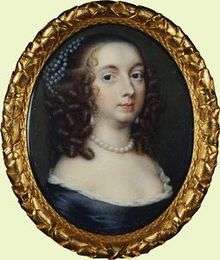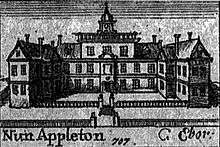Anne Fairfax
| Anne Fairfax | |
|---|---|
 | |
| Born | 1610 |
| Died |
1665 Nun Appleton Hall |
| Spouse(s) | Thomas Fairfax |
Anne, Lady Fairfax (born Anne Vere, also known as Anne Fairfax) (1617/8 – 1665) was an English noblewoman. She was the wife of Thomas Fairfax, 3rd Lord Fairfax of Cameron, commander-in-chief of the New Model Army. She followed her husband as he fought and she was briefly taken prisoner. It is said that she was ejected after heckling the court at the trial of Charles I.
Life
Anne Vere was born in 1617 or 1618 in the Netherlands. Her parents were Elizabeth and Horace Vere, 1st Baron Vere of Tilbury. Her father was a commander during the 80 years and Thirty Years War. Anne married Thomas Fairfax who rose to lead the New Model Army during the English Civil War. Anne was a woman of influence and she accompanbied her husband to battles. She was taken prisoner near Bradford by William Cavendish, 1st Duke of Newcastle, but she was released a few days later and given an escort back to her husband's army.[1]

Her husband was placed at the head of the judges who were to try Charles I, but , convinced that the king's death was intended, he refused to act. Fairfax did not attend the King's trial but Anne did. When the court called the name of Fairfax, it is said that his wife, Anne Fairfax, said "he had more wit than to be there". Later when the court said that they were acting for "all the good people of England", she shouted ‘No, nor the hundredth part of them!". This resulted in an investigation and Anne was asked or required to leave the court.[1] It was said that Anne could not forbear, as Bulstrode Whitelocke says, to exclaim aloud against the proceedings of the High Court of Justice.[2] In February 1649 Fairfax was elected Member of Parliament for Cirencester in the Rump Parliament.[3] Anne and her mother were later asked by John Geree in January 1649 to intercede on the King's behalf to prevent his execution.
Anne's daughter Mary married the royalist George Villiers, 2nd Duke of Buckingham when he returned to England in 1657. This was despite their daughter's imminent marriage to Philip Stanhope, 2nd Earl of Chesterfield.[4]
Anne and her husband had to negotiate a £20,000 surety to allow their son-in-law, the Duke of Buckingham, to be released from the Tower of London in 1659 after he was arrested.[1]
Fairfax died in Nun Appleton Hall in 1665.[5] Her husband died there too six years later.
References
- 1 2 3 Jacqueline Eales, ‘Fairfax , Anne, Lady Fairfax (1617/18–1665)’, Oxford Dictionary of National Biography, Oxford University Press, 2004 accessed 10 April 2017
- ↑ Chisholm 1911, p. 131.
- ↑ Helms & Cruickshanks 1983
- ↑ Bruce Yardley, ‘Villiers, George, second duke of Buckingham (1628–1687)’, Oxford Dictionary of National Biography, Oxford University Press, 2004; online edn, May 2009 accessed 10 April 2017
- ↑ Jacqueline Eales, ‘Fairfax , Anne, Lady Fairfax (1617/18–1665)’, Oxford Dictionary of National Biography, Oxford University Press, 2004 accessed 10 April 2017
Sources
 This article incorporates text from a publication now in the public domain: Chisholm, Hugh, ed. (1911). "Fairfax of Cameron, Thomas Fairfax, 3rd Baron". Encyclopædia Britannica. 10 (11th ed.). Cambridge University Press. pp. 130–131.
This article incorporates text from a publication now in the public domain: Chisholm, Hugh, ed. (1911). "Fairfax of Cameron, Thomas Fairfax, 3rd Baron". Encyclopædia Britannica. 10 (11th ed.). Cambridge University Press. pp. 130–131.